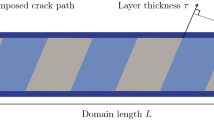Abstract
In connection with the massive introduction of nanocrystalline and nanocomposite materials in which elastic deformation can reach more than 3%into engineering practice, arises the need for the formulation of nonlinear elastic equations and the basic criteria for fracture mechanics. Current coefficient of transverse deformation [1, 2, 3] is used in this article and nonlinear elastic equations and a modified Griffith strength criterion [4] for a cracked specimen are formulated. On the basis of this criterion, the values of theoretical and real strength are estimated. Three cases are considered: an ideal lattice without defects, nanocrystalline and nanocomposite materials with crack sizes within a few nanometers, a laboratory sample with a micron size of cracks. It is shown that the theoretical strength is two orders of magnitude greater than the strength of the laboratory sample. This result is in agreement with the known estimates in the literature [5]. In the case when the material has cracks of the order of nanosizes, there is a significant reduction in strength (within one order of magnitude of theoretical strength).
Similar content being viewed by others
References
R. A. Arutyunyan, The problem of deformational aging and long-term destruction in the mechanics of materials (Izd-vo StPbGU, St. Petersburg, 2004) [in Russian].
R. A. Arutyunyan, “Creep Fracture of Nonlinear Viscoelastic Media Undergoing UV Radiation,” Int. J. Fract. 132 (1), L3-L8 (2005).
A. Y. Ishlinsky, “Euler Description of the Deformation of one Isotropic Medium,” in Applied Problems of Mechanics, Vol. 1 (Nauka, Moscow, 1986) pp. 333–335 [in Russian].
A. A. Griffith, “The Phenomena of Rupture and Flow in Solids,” Phil. Trans. Roy. Soc. London. Ser. A 221, 163–198 (1921).
J. F. Knott, Fundamentals of Fracture Mechanics (Butterworth and Co., 1973; Metallurgiya, Moscow, 1978) [in Russian].
S. N. Kulkov, “Structure, Phase Composition and Mechanical Properties of ZrO2-based Nanosystems,” Fizich.Mezomekh. 10 (3), 81–94 (2007) [Phys.Mesomech. (Engl. Transl.) 11 (1-2), 29–41 (2008)].
S. N. Kul’kov, V. I. Maslovskii, S. P. Buyakova, and D. S. Nikitin, “The Non-HookeТs Behavior of Porous Zirconia Subjected to High-Rate Compressive Deformation,” Zh. Tekhn. Fiz. 72 (3), 38–42 (2002) [Techn. Phys. (Engl. Transl.) 47 (3), 320–324 (2002)].
W. Koster and H. Franz, “Poisson’s Ratio forMetals and Alloys,” Metal. Rev. 6 (21), 1–56 (1961).
A.M. Zhukov, “On the Poisson’s Ratio in the Plastic Region,” Izv. Akad. Nauk SSSR. OTN No. 12, 86–91 (1954).
H. Liebowitz (Editor), Fracture: an Advanced Treatise. Vol. 7. Fracture of Nonmetals and Composites. Part 1: InorganicMaterials (Glass, Rocks, Composites, Ceramics, Ice) (Mir,Moscow, 1976) [inRussian].
S. P. Timoshenko and J. Goodier, Theory of Elasticity (Nauka, Moscow, 1975; McGraw-Hill, New York, 1987).
A. F. Ioffe, Crystal Physics (Gostekhizdat, Moscow, 1929) [in Russian].
A. F. Ioffe, N. V. Kirpicheva, and M. A. Levitskaya, “Deformation and Strength of Crystals,” Zh. Russ. Fiz.-Khim. Obshch. im. D. I. Mendeleeva.Ch. Fiz. 56, 489–503 (1924).
I. S. Grigorieva and E. Z. Meilikhov (Editors), Reference Book. Physical Quantities (Energoatomizdat, Moscow, 1991) [in Russian].
Author information
Authors and Affiliations
Corresponding author
Additional information
Original Russian Text © A.R. Arutyunyan, R.A. Arutyunyan, 2018, published in Izvestiya Akademii Nauk, Mekhanika Tverdogo Tela, 2018, No. 3, pp. 129–134.
About this article
Cite this article
Arutyunyan, A.R., Arutyunyan, R.A. Application of the Griffith Energy Concept to the Formulation of the Strength Criteria for Nonlinear-Elastic Medium with a Crack. Mech. Solids 53, 349–353 (2018). https://doi.org/10.3103/S0025654418070130
Received:
Published:
Issue Date:
DOI: https://doi.org/10.3103/S0025654418070130




